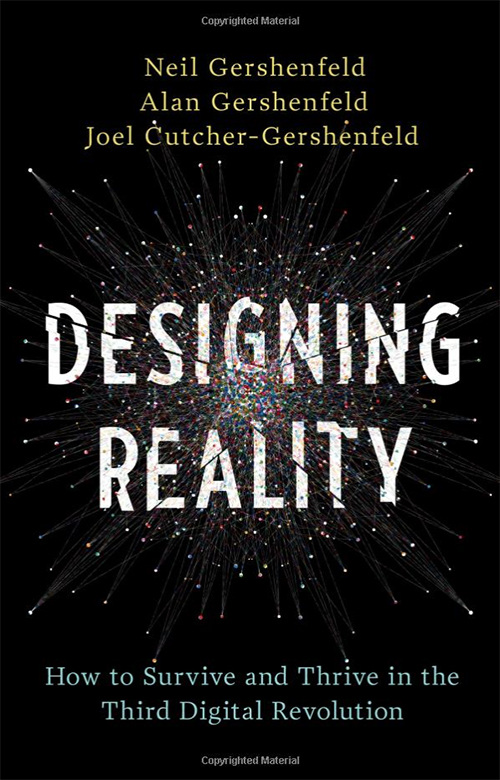Heller Communications met with Professor Joel Cutcher-Gershenfeld for an interview about his new book, "Designing Reality: How to Survive and Thrive in the Third Digital Revolution" (Basic Books, 2017), which he coauthored with his two brothers: Neil Gershenfeld, director of the Center for Bits and Atoms at MIT, and Alan Gershenfeld, president of E-Line Media.
Together, they explore a not-so-distant future in which advances in digital fabrication technology allow anyone to make (almost) anything; a revolution that could promote self-sufficiency and democratize material goods if we make wise choices now, or deepen existing digital divides, if we don’t.
Heller Communications: Let’s start with your unusual coauthor arrangement: What’s it like to write a book with your two brothers?
Joel Cutcher-Gershenfeld: [Chuckles] Starting with the three of us is the right place to start, actually. The book takes seriously this idea of the third digital revolution, which one of my brothers, Neil, has been a world leader in helping to bring about. Too often, stories about technology are just told about the technology—so this book pairs Neil’s technology story with my perspective as a social scientist, and my brother Alan’s work in humanities. Having a three-way conversation between science, social science and humanities is appropriate and all too rare.
HC: Was this the first time the three of you worked on a project this significant?
JCG: Other than growing up together, yes.

HC: Fair enough! So the book itself explores the impending third digital revolution. What are the first and second?
JCG: The first two digital revolutions were communication and computation, which began about a half-century ago. If you go back to 1965 when Gordon Moore wrote his famous article about what he called "cramming more components onto integrated circuits," he predicted that 10 years of exponential growth would result in fundamentally different world of computer wristwatches and computer-assisted driving in cars. Of course, he predicted a 1,000-fold increase within 10 years, and he was slightly off: we’ve had 50 years of exponential growth and a billion-fold increase in computation capability.
Technologists were listening back in 1965, but social scientists, policymakers and average citizens were not. As a result, we have all the wonderful affordances of digital technology, but we also have deep digital divides, where some people have access to increasingly valuable and necessary technology, knowledge and civic engagement, and others do not. So we didn’t quite get it right.
The third digital revolution is digital fabrication, and we’re now ten years into that movement. What prompted the book is that the number of fabrication labs, or “fab labs” and maker spaces is now doubling every year and a half—an exponential growth curve that parallels Moore’s Law.
HC: When you say “fab labs and maker spaces,” are you referring to 3-D printing, or does it encompass more than that?
JCG: Everyone thinks of 3-D printing, but it’s much more than that. My brother Neil’s analogy is that the 3-D printer is to digital fabrication what the microwave was in the 1970s to the kitchen of the future. It’s just one product. There’s also digital laser cutters, 3-D scanners, 3-D milling machines, computer design software; there’s so much more.
If you think back to when computers filled entire rooms, they numbered in the thousands. Fab labs are today’s equivalent: they now fill entire rooms and number in the thousands. Over the next 50 years, the size of the equipment will shrink and the capabilities will be more multifunctional, and it’s that capability that is doubling approximately every 18 months.
HC: So if we get a billion-fold increase in the ability of anyone to make (almost) anything over the next 50 years, what happens?
JCG: That’s the central question of this book. The answer is it will disrupt global supply chains, because cities could become self-sufficient and make what they need. People won’t have to buy certain things anymore, they’ll be able to go to a community fab lab and make them from open source designs. Suddenly, the whole notion of work and employment and play get disrupted in all sorts of ways.
If we have the conversations now about access and literacy – conversations that we didn’t have with the first two digital revolutions – we can shape the technology in a way that helps many more people to attend to their basic needs and have dignity. If we don’t, there will likely be a deepening of digital divides.

HC: All the talk of self-sufficiency is making me think of environmental concerns. What do you see as the environmental impacts of this revolution?
JCG: If you walk into a fab lab today, they’re using plastic, plywood—a number of materials that are not environmentally sound. If the number of fab labs continues to double, that could become really catastrophic. On the other hand, there’s an emerging movement to design and build things from local materials that match the environment around us, which has potential to mitigate environmental impacts.
In about 15-20 years, we’ll begin to see an increase in this use of digital and programmable materials, sort of like Lego blocks that you can assemble and disassemble. There is interesting work now being done at the nano level to create small digital building blocks that can be used and reused. At that point the environmental catastrophe becomes less of a concern.
HC: Is there one major technological puzzle that’s holding this back, like the battery for electric cars?
JCG: It’s still unclear how the technology will shrink down, bringing fabrication from community fab labs to personal fabrication. Will that mean you have a fabricator in your briefcase, in your office, in your kitchen? Or is it a neighborhood center? We’ve seen prototypes of all of the above, but who knows what will take off. Increasingly, the frontier of this technology is using digital components to do micro-assembly. There is even assembly work taking place at the atomic level.
But in terms of a major technological limiting factor—not really. The technology seems to be advancing at a exponential pace. What is not advancing at the same pace are the social system. Change in the social systems tends to be linear. With the technology, we haven’t yet hit the knee of the curve. That’s always when it catches everyone by surprise, but at that point social system assumptions are already baked into the technology.
The point of the book is that we shouldn’t wait unit the technology catches us by surprise; we should be having certain conversations now. What kind of society, what kind of economy do we want to have with this technology? What about literacy and inclusion, and risk mitigation? If we wait until things go exponential, it’s too late.
HC: So where are these conversations happening?
JCG: There are several examples. The city of Pittsburgh has over 100 fab labs and maker spaces in schools, libraries, community colleges, and community centers. It is an entire ecosystem involving over 2,000 educators in the region, with a focus on project-based learning. The initiative, entitled “Remake Learning” is weaving together ideas in what is now a global center for robotics in what was previously dying steel town.
Barcelona is having conversations about building neighborhood fabrication facilities, and the educational systems to go with them. In Detroit, Insight Focus has built a large central lab and a network of satellite labs focused on food permaculture; converting food deserts into food self-sufficiency, housing, and other basic needs.
In India, there’s a fab lab in a rural community that’s making incubators for chickens and other things to promote local self-sufficiency. In rural Africa, people are using fab labs to make extenders for the Internet. This goes back to the digital divide—you can have technology reach into more rural communities by designing the antenna and connections yourself.
Once you have the ability to design and make things, the limit is your imagination.
HC: Any closing thoughts?
JCG: The fab movement has the potential to be a great equalizer. But technology is never good or bad; nor is it neutral. It gets used in ways that have good and bad consequences, and it has multipliers. Right now, the motivation for the book is that we see the potential for some positive, equalizing multipliers, but only if we make the right choices early on.
There’s a long history in the social sciences of observing and reacting to technology rather than leaning in and shaping it. As scientists you’re supposed to sit at arm’s length and study things. It’s still the case that most technologists aren’t talking to people in the humanities or the social sciences, or having sufficient conversations about ethics, governance, and values.
What is at stake is a new blend of economic models – traditional business, public sector, nonprofit social impact, and a growing ability for people to make what they need. This latter category has echoes of ancient barter and local self-sufficiency, with additional aspects of global connectivity. These are not just technology challenges.
The way we had to push ourselves as three brothers to work together on this book is a metaphor for what we need to do in society.
